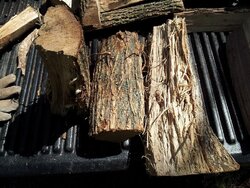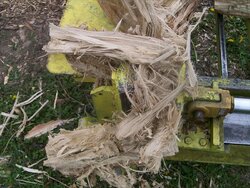Wood ID.....Elm?
- Thread starter dannynelson77
- Start date
-
Active since 1995, Hearth.com is THE place on the internet for free information and advice about wood stoves, pellet stoves and other energy saving equipment.
We strive to provide opinions, articles, discussions and history related to Hearth Products and in a more general sense, energy issues.
We promote the EFFICIENT, RESPONSIBLE, CLEAN and SAFE use of all fuels, whether renewable or fossil.
You are using an out of date browser. It may not display this or other websites correctly.
You should upgrade or use an alternative browser.
You should upgrade or use an alternative browser.
- Status
- Not open for further replies.
Backwoods Savage
Minister of Fire
nrford
Minister of Fire
S
ScotO
Guest
chinkapin_oak
Member
Locust Post
Minister of Fire
D
DexterDay
Guest
Here is some Elm I cut last year. Very Stringy indeed....
https://www.hearth.com/talk/threads/wood-i-d-please-stringy.68997/
https://www.hearth.com/talk/threads/wood-i-d-please-stringy.68997/
firefighterjake
Minister of Fire
timusp40
Feeling the Heat
77,
Oh yeah it's Elm and your photo brings back some unpleasant hand splitting memories.
Have fun,
Tim
Oh yeah it's Elm and your photo brings back some unpleasant hand splitting memories.
Have fun,
Tim
Ashful
Minister of Fire
So, if you were doing all your splitting by hand, and you didn't have an endless supply of wood on your own property (I have tons of cedar, which is not so choice), would you pass up free elm? I've been offered some, and have not experienced splitting this stuff myself, yet. Is there any possibility of halving the rounds with the chainsaw, and then splitting half rounds from there? I've had good success doing that with cedar, which is also notoriously difficult, due to knots every few inches down the length of any given split.
So, if you were doing all your splitting by hand, and you didn't have an endless supply of wood on your own property (I have tons of cedar, which is not so choice), would you pass up free elm? I've been offered some, and have not experienced splitting this stuff myself, yet. Is there any possibility of halving the rounds with the chainsaw, and then splitting half rounds from there? I've had good success doing that with cedar, which is also notoriously difficult, due to knots every few inches down the length of any given split.
Hand splitting of a difficult elm (and I differentiate - some aren't bad, some are monsters) is a bit different than other species. I have always had my best luck by slabbing off the sides.
It really comes down to the tree. In the pics above - you ain't hand splitting that, but that tree was the worst of any that I have EVER seen. The average elm is gonna be more work than a nice clean hickory, but it is splittable.
Wood Duck
Minister of Fire
I would take free Elm if it was offered. I think the splits you show in the picture are on the hard-to-split end of the elm spectrum. Sure, it gets worse, but you also encounter some elm that isn't so bad. It burns a lot longer than cedar (I am assuming you have Eastern Red Cedar, which is nice but low density firewood) so I would want to have some for overnight burns.
firefighterjake
Minister of Fire
So, if you were doing all your splitting by hand, and you didn't have an endless supply of wood on your own property (I have tons of cedar, which is not so choice), would you pass up free elm? I've been offered some, and have not experienced splitting this stuff myself, yet. Is there any possibility of halving the rounds with the chainsaw, and then splitting half rounds from there? I've had good success doing that with cedar, which is also notoriously difficult, due to knots every few inches down the length of any given split.
Well not knowing where you are and if you're talking red or white cedar . . . I know eastern white cedar is typically one of the easier to split woods as long as there are not a lot of knots.
Elm on the other hand is considered evil by many folks who split by hand . . . that said . . . American elm can also split up pretty easy . . . depending on the condition. When I've split up standing dead elm with the bark actually falling off it split pretty easily with very little issues or stringiness (albeit it was with a hydraulic splitter). Live elm however typically is a whole other experience . . . even with a hydraulic splitter.
So to answer the question . . . I guess I would take the elm if it's free . . . try splitting it by hand, but if it is just too miserable you can put it to the side and when you get enough of whatever wood you have rent a splitter if necessary.
onetracker
Minister of Fire
Now...for the true gore of elm, I present...
THAT
is a riot.
imagine trying to split that by hand?
great photos
blujacket
Minister of Fire
Backwoods Savage
Minister of Fire
I split a bunch of elm today. None of it was stringy either. Split like a charm. The key is that it was dead and most of the bark had fallen before we cut it. This is what you need with elm.
Ashful
Minister of Fire
Well not knowing where you are and if you're talking red or white cedar . . . I know eastern white cedar is typically one of the easier to split woods as long as there are not a lot of knots.
Philadelphia area. Not sure what type of cedar I have, but the heartwood is an almost unnatural shade of bright pink. Smells wonderful when cutting, and ripping it makes piles of long curly shavings to carpet the splitting area. The rare clear piece does split with ease, but most pieces are full of knots, which hold the splits together like carriage bolts.
ailanthus
Feeling the Heat
Philadelphia area. Not sure what type of cedar I have, but the heartwood is an almost unnatural shade of bright pink. Smells wonderful when cutting, and ripping it makes piles of long curly shavings to carpet the splitting area. The rare clear piece does split with ease, but most pieces are full of knots, which hold the splits together like carriage bolts.
Sounds like red cedar to me; there's a ton of it here as well - actually a juniper rather than a true cedar. I had some in a pile that had seasoned for a couple years before splitting & I thought it hand split pretty easily for something with so many knots. (was also very dry & ready to burn right after splitting)
firefighterjake
Minister of Fire
Sounds like red cedar to me; there's a ton of it here as well - actually a juniper rather than a true cedar. I had some in a pile that had seasoned for a couple years before splitting & I thought it hand split pretty easily for something with so many knots. (was also very dry & ready to burn right after splitting)
I agree . . . around here we have eastern white cedar and other than an occasional pink tinge in the center it's almost always a white wood.
Ashful
Minister of Fire
Question is, does it make decent fuel? I had read it's really only good for kindling, and not good as a primary fuel. So I was splitting a lot of 12" - 18" knotty rounds into 1" kindling, which was not so fun.
Elm makes for fine stove chow. It ain't hickory or Oak, but it is somewhere in the middle of the pack as far as output goes.
firefighterjake
Minister of Fire
Elm makes for fine stove chow. It ain't hickory or Oak, but it is somewhere in the middle of the pack as far as output goes.
I think he was talking about the red cedar . . . but if he was talking about elm . .. yeah, good wood. I use a fair amount of it.
I think he was talking about the red cedar . . . but if he was talking about elm . .. yeah, good wood. I use a fair amount of it.
Yeah, your probably right, Jake.
- Status
- Not open for further replies.
Similar threads
- Replies
- 33
- Views
- 2K
- Replies
- 15
- Views
- 1K




